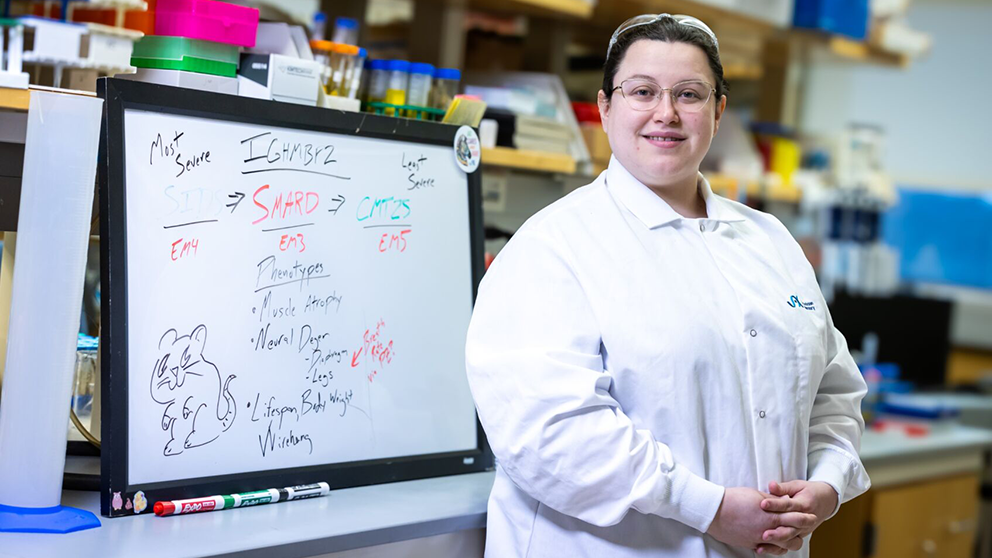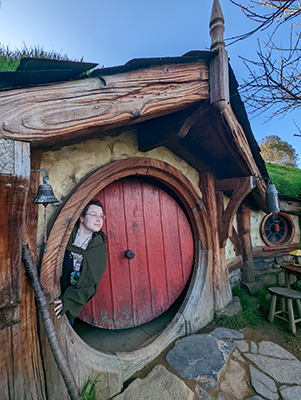 The Jackson Laboratory's Sarah Holbrook. Photo credit: Tiffany Laufer
The Jackson Laboratory's Sarah Holbrook. Photo credit: Tiffany Laufer
“The road goes ever on and on, down from the door where it began. Now far ahead the road has gone, and I must follow if I can.” – Bilbo Baggins
Discovery can only come about with dedication and unwavering passion. Sarah Holbrook, a Ph.D. candidate at the University of Maine, is completing the final leg of her journey at The Jackson Laboratory. And what a journey it has been. Under the tutelage of Associate Professor Gregory Cox, Ph.D., Holbrook set out on a quest to provide genetic insights into a rare disease, spinal muscular atrophy with respiratory distress (SMARD). The quest has proven fruitful, but in truth Holbrook’s journey to JAX began many years prior.
The road goes ever on and on
Surrounded by potato blossom festivals and potentials for moose sightings, Holbrook was born and raised in northern Maine. As a child of a single parent, her family, like so many in the state and across the country, suffered from a long history of drug use, illiteracy and alcoholism. When she was five and her sister only two, her mother made the tough decision to move her small family further north. Two kind acquaintances took in the mother and the girls and quickly became their adopted grandparents. Holbrook remembers witnessing her mother sacrificing what little food they had so her daughters could eat and recalls her mom stressing to them the importance of education so they could live their dreams.
“Despite our family struggles, my mom instilled in my younger sister and I that we needed to get a good education. This was mostly because she herself did not complete high school,” says Holbrook. “She had dropped out to take care of her brothers, but she later went back to get a GED to show us how important it was to at least have a high school education.”
Holbrook graduated valedictorian of her high school class.
Down from the door where it began
While she did not know it at the time, an early experience shaped Holbrook’s desire to pursue rare disease research. In elementary school, she participated in a reading buddy program where she met a student in a wheelchair who did not have anyone to read with. Holbrook took the student under her wing, reading him The Berenstain Bears and forgoing outdoor recess to share her Beanie Baby collection.
“The special education teachers always cryptically told me not to get attached, but they never told me why,” says Holbrook. “One year, after Christmas break, he just was not there. It turned out that my friend had passed away from Batten disease, a rare progressive genetic disorder that affects the brain and nervous system. At the end, he could not get out of the wheelchair or lift his head up. I wish I had been given a better explanation about what happened to him.”
Her friend’s fate, combined with the desire to know more about the biological component behind addiction and alcoholism, fueled Holbrook’s desire to become a scientist. It all came to a head when she was able to visit a laboratory and witness research for the first time. That lab was The Jackson Laboratory, also known as JAX.
“We went to JAX for a field trip where we were able to see what a lab looked like, meet researchers, and view all the variations of mice models. We saw so many kinds of mice, but when I witnessed the glow-in-the-dark mice, I knew. This was where I wanted to work.”
Graduating from her undergraduate program with high honors, Holbrook was accepted to the Graduate School of Biomedical Science and Engineering program at the University of Maine, a multi-institutional research consortium allowing students to pursue their Ph.D. studies while working in state-of-the-art research facilities. Fulfilling her teenage dream, she began her studies at JAX. Despite accomplishing a tremendous goal, Holbrook’s financial situation remained tough. She continued to work odd jobs to get through school while also supporting her mother.
“I never wanted my mom to worry. I always told her, ‘Someday I will make it big and get that house I promised you when I was younger,’” says Holbrook.
Before Holbrook’s first semester of her Ph.D., a close family friend lost her decades-long battle against cancer. Holbrook began to question whether she was really cut out to pursue a doctorate degree. Graduating from high school was already an achievement, let alone graduating from college. Going to graduate school was pushing her luck. Around Halloween, Holbrook got a call. Her mom was in the hospital, having suffered a heart attack. A few days later, she passed away.
“She was my only parent. My sister and I did not know what to do,” says Holbrook.

Shortly before her mother passed, Holbrook tracked down her biological father. They were able to connect. She discovered where her cat allergy came from and her curly hair. The two talked for hours that day, but afterwards, interactions were brief and infrequent.
“Right before I left, he told me he loved me. He said his father never had the chance to say that to him before his dad died. Months later, my biological father passed away. That was another hit,” says Holbrook.
Now far ahead the road has gone
Holbrook threw herself into her work. She put all of her time into her projects, studying rare neuromuscular diseases, in particular spinal muscular atrophy with respiratory distress (SMARD). Children with this rare disease typically die before the age of six owing to severe muscle wasting leading to the inability to breathe. Depending on the severity of the condition, SMARD and its subtypes can be misdiagnosed as sudden infant distress syndrome since infants with SMARD can suddenly stop breathing. Sometimes, it is not until another child is born and survives with a milder presentation of the disease that there is a proper diagnosis. Less severe cases of SMARD begin in adulthood with initial loss of peripheral motor mobility and sensory neuropathy. While there are less severe respiratory symptoms as an adult, inevitably the rib muscles waste away, leaving patients on ventilators for life.
Holbrook’s mentor, Greg Cox, Ph.D., had originally found the causative gene, IGHMBP2, for SMARD in the early 1990s during his postdoctoral studies at JAX. He developed many mouse models, 11 in total, to demonstrate the spectrum of severity human patients experience. When Nationwide Children’s Hospital reached out to the Cox lab to test a new gene therapy, Holbrook seized on the opportunity to make a true clinical impact. Using two mouse models, EM3 and EM5, Holbrook tested a new gene therapy. The EM3 mice represented the more severe cases of SMARD, living for only about three weeks with about 10% living past that age with severe paralysis, while the EM5 mice modeled the milder form of the human mutation, technically called Charcot-Marie-Tooth disease type 2S. EM5 mice experience motor and neuron loss at around six to eight weeks.
“Initially, we did not have much hope for the therapy, since the window of survival is so small for these mice. In severe cases, even if they received the treatment at one day old, they are already rapidly losing nerve and muscle,” says Holbrook.
But miraculously, the treatment worked. When receiving the treatment from day one, the EM3 mice proved to gain strength and develop an excellent body condition. They were reportedly ~50% larger than non-treated mice at the end of the eight-week pilot trial and only ~25% lighter than their wildtype siblings. The EM5 models exhibited even more success. Some mice were completely cured and boasted bigger muscles than their nonaffected siblings.
“To have this success occur at such a difficult time for me was healing. I knew that my mom would have loved that I was helping save lives,” says Holbrook.
And I must follow if I can
While working countless hours on the gene therapy trial, Holbrook received another devastating call. Her older brother was hospitalized with a severe case of flu, and in February 2020 at the age of 41, he passed away. After losing yet another family member who had taught her the meaning of hard work and a love of scary movies, she rested for a week. Ready to continue her work, she hoped for her world to go back to some form of normalcy.
As we now know, Holbrook soon faced another, completely unexpected, challenge: the pandemic. She took it upon herself to work nights, holidays and weekends to accommodate the early COVID-19 capacity guidelines while dealing with the grief of those she had recently lost. But during this time of loss and disruption, Holbrook got to know Brittany Steinman, one of the founders for smashSMARD, an organization also working with Nationwide Children’s Hospital that played a major role in creating the SMARD vector treatments Holbrook was testing for clinical trial.
“I know what it is like to have empty seats during the holidays. That’s part of why I poured myself even more so into work. And for those like my reading buddy’s family and so many others who have lost people to rare disease, those empty seats are not just reminders of those who have been lost. They leave them riddled with questions about what exactly took their loved ones,” says Holbrook. “Meeting with Brittany and Nash, a child with SMARD, was a therapeutic experience for me. We laughed together. We cried together. It motivated me to work even harder to get this treatment to clinical trial.”
Despite also losing her maternal grandmother, newfound paternal grandmother and the adopted grandfather who took in her family all those years ago, she continued her research. In 2021, the gene therapy Holbrook spent so long testing was approved for human trials. The clinical trial is still currently in progress and is set to wrap up in November 2026.
Finding fellowship
Holbrook relied heavily on her mentor, Greg Cox, throughout the highs and lows of her time as a graduate student. From helping her fix her car, to sharing a grilled cheese and soup, to coaxing her to join the JAX choir, she describes him as not only a mentor but also family. Literally. In early September 2023, Holbrook became engaged to Dr. Cox’s son, Ryan, whom she had dated for three years.
“Dr. Cox has really taken me under his wing. But he does that with everyone at JAX. He is known as Science Dad,” says Holbrook. “If I was in any other lab, I am not sure if I would be here today. Even though I have experienced so much loss, I have gained so much family.”
Holbrook is hoping to pursue a postdoctoral position upon her graduation from her doctoral program. She will continue her studies in rare disease and seeks to expand her projects with other rare neuromuscular diseases such as ALS and limb girdle disease. She hopes to return to JAX one day as a full-time faculty member. In the meantime, she will continue to wrap up her projects, volunteer in after-school mentor programs and attend JAX karaoke nights after having found her family.